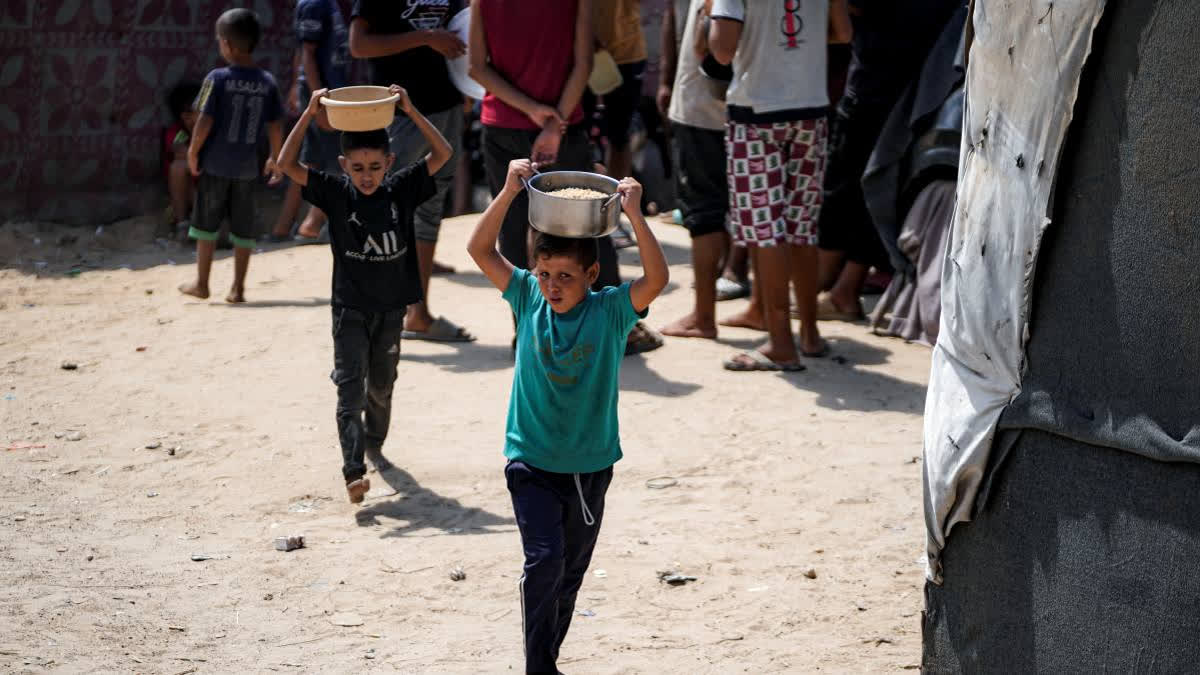Khan Younis (Gaza Strip): This week, when they would normally be going back to school, the Qudeh family's children stumbled with armfuls of rubble they collected from a destroyed building to sell for use in building graves in the cemetery that is now their home in southern Gaza.
"Anyone our age in other countries is studying and learning," said 14-year-old Ezz el-Din Qudeh, after he and his three siblings — the youngest a 4-year-old — hauled a load of concrete chunks. "We're not. We're working at something beyond our capacities. We are forced to in order to get a living."
As Gaza enters its second school year without schooling, most of its children are caught up helping their families in the daily struggle to survive amid Israel's devastating campaign.
Children trod barefoot on the dirt roads to carry water in plastic jerricans from distribution points to their families living in tent cities teeming with Palestinians driven from their homes. Others wait at charity kitchens with containers to bring back food.
Humanitarian workers say the extended deprivation of education threatens long-term damage to Gaza's children. Younger children suffer in their cognitive, social and emotional development, and older children are at greater risk of being pulled into work or early marriage, said Tess Ingram, regional spokesperson for UNICEF, the United Nations agency for children.
"The longer a child is out of school, the more they are at risk of dropping out permanently and not returning," she said.
Gaza's 625,000 school-age children already missed out on almost an entire year of education. Schools shut down after Israel launched its assault on the territory in retaliation for Hamas' Oct. 7 attack on southern Israel. With languishing negotiations to halt fighting in the Israel-Hamas war, it's not known when they can return to classes.
More than 90% of Gaza's school buildings have been damaged by Israeli bombardment, many of them run by UNWRA, the U.N. agency for Palestinians, according to the Global Education Cluster, a grouping of aid organizations led by UNICEF and Save the Children. About 85% are so wrecked they need major reconstruction — meaning it could take years before they are usable again. Gaza's universities are also in ruins. Israel contends that Hamas militants operate out of schools.
Some 1.9 million of Gaza's 2.3 million people have been driven from their homes. They have crowded into the sprawling tent camps that lack water or sanitation systems, or U.N. and government schools now serving as shelters.
Kids have little choice but to help families
Mo'men Qudeh said that before the war, his kids enjoyed school. "They were outstanding students. We raised them well," he said.
Now he, his four sons and his daughter live in a tent in a cemetery in Khan Younis after they had to flee their home in the eastern neighborhoods of the city. The kids get scared sleeping next to the graves of the dead, he said, but they have no alternative.
The continual flow of victims from airstrikes and shelling into the cemetery and the plentiful supply of destroyed buildings are their source for a tiny income.
Every day at 7 a.m., Qudeh and his children start picking through rubble. On a recent day of work, the young kids stumbled off the pile of wreckage with what they found. Qudeh's 4-year-old son balanced a chunk of concrete under his arm, his blonde curly hair covered in dust. Outside their tent, they crouched on the ground and pounded the concrete into powder.
On a good day, after hours of work, they make about 15 shekels ($4) selling the powder for use in constructing new graves.
Qudeh, who was injured in Israel's 2014 war with Hamas, said he can't do the heavy work alone.
"I cry for them when I see them with torn hands," he said. At night, the exhausted children can't sleep because of their aches and pain, he said. "They lie on their mattress like dead people," he said.
